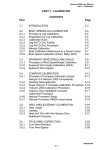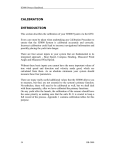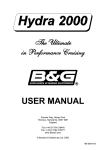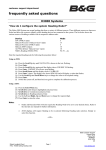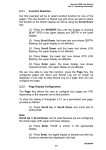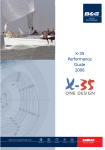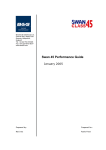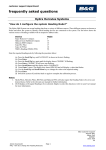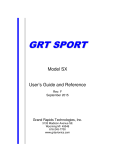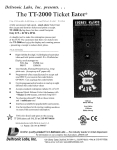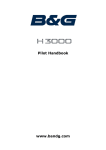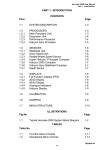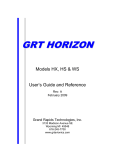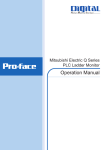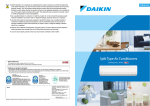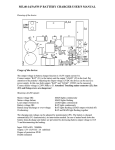Download Hydra-Pt 3-Cal_man - Chicago Marine Electronics
Transcript
Hydra 2000 User Manual Part 3 - Calibration PART 3 - CALIBRATION CONTENTS Para Page 3.1 INTRODUCTION 3-3 3.2 3.2.1 3.2.2 3.2.3 3.2.4 3.2.5 3.2.6 3.2.7 3.2.8 BOAT SPEED/LOG CALIBRATION Principle of Log Calibration Preparation for Log Calibration Calibration Runs Log AUTO CAL Facility Log AUTO CAL Procedure Manual Calibration Boat Speed Calibration (ref. to a Known Value) Boat Speed Calibration (Knots, MPH, KPH) 3-4 3-4 3-4 3-4 3-5 3-6 3-7 3-7 3-8 3.3 APPARENT WIND SPEED/ANGLE CALIBRATION Principles of Wind Speed/Angle Calibration Apparent Wind Angle Calibration (AWA) Apparent Wind Speed Calibration 3-9 3-9 3-10 3-11 3.3.1 3.3.2 3.3.3 3.4 3.4.1 3.4.2 3.4.3 3.4.4 3.4.5 3.4.6 3.4.7 COMPASS CALIBRATION 3-12 Principles of Compass Calibration (Super Halcyon 3 & Halcyon 2000 Compasses) 3-12 Heading Node Selection 3-13 Super Halcyon 3 Compass Calibration Procedure3-14 Halcyon 2000 Calibration Procedure 3-15 Halcyon Gyro Stabilised Calibration Procedure 3-16 Halcyon Processor Setup 3-18 Halcyon Processor NMEA Output 3-18 3.5 3.5.1 3.5.2 3.5.3 HEEL ANGLE/LEEWAY CALIBRATION Heel Angle Calibration Leeway Calibration Heel and Trim Angle with the Halcyon Gyro Stabilised Compass 3-19 3-19 3-19 3-21 3.6 3.6.1 3.6.2 TRUE WIND CORRECTION True Wind Direction Calibration True Wind Speed Calibration 3-21 3-22 3-25 HB-0844-04 3-1 Hydra 2000 User Manual Part 3 - Calibration 3.7 DEPTH CALIBRATION HB-0844-04 3-2 3-26 Hydra 2000 User Manual Part 3 - Calibration CONTENTS (Contd.) Para Page 3.8 BATTERY VOLTS CALIBRATION 3-26 3.9 3.9.1 SEA TEMPERATURE CALIBRATION Sea Temperature Offset Calibration 3-27 3-27 ILLUSTRATIONS Fig No 3.1 3.2 3.3 3.4 3.5 3.6 3.7 Page Log Calibration Runs Masthead Unit Alignment Leeway Angle Measurement True Wind Direction Upwash True Wind Direction Error Depth Datum 3-5 3-10 3-20 3-22 3-23 3-24 3-26 TABLES Table No Page 3.1 3.2 3-23 3-25 Example of True Wind Angle Correction Table Example of True Wind Speed Correction Table HB-0844-04 3-3 Hydra 2000 User Manual Part 3 - Calibration PART 3 - CALIBRATION 3.1 INTRODUCTION WARNING - Every care must be taken when undertaking any Calibration Procedure to ensure that the Hydra 2000 System is calibrated accurately and correctly. Incorrect calibration could lead to incorrect navigational information. Calibration of an integrated instrument system is probably one of the most misunderstood, processes in the world of yachting. Rather in the way that fast sails badly trimmed will add little or nothing to the boat’s performance, racing instruments badly calibrated, will also achieve very little. This part of the manual removes some of the mystique and breaks the calibration process down into a series of simple instructions. These instructions when carefully undertaken in the right order will consistently produce good results. There are four basic inputs to your system that are fundamental to its integrated approach - Boat Speed, Compass Heading, Apparent Wind Angle and Apparent Wind Speed. Without these four basic inputs, correctly calibrated, you cannot have the more interesting values of true wind speed and direction, and velocity made good, which are calculated from them. On any yacht the calibration of these items should be as high on the job list, after the launch, as making sure the sails fit. Finally, it is crucial to keep a full record of the process. Appendix 1 contains calibration tables designed specifically for recording your results. HB-0844-04 3-4 Hydra 2000 User Manual Part 3 - Calibration 3.2 BOAT SPEED/LOG CALIBRATION 3.2.1 Principle of Log Calibration To calibrate the log it is necessary to work out the number of revolutions of a paddle-wheel, or sonic pulses per second that correspond to each knot of Boat Speed. The Boat Speed/Log calibration value is always shown as Hertz/Knot (Hz/Kt). The Hydra 2000 allows you to calibrate both a single or a dual sensor unit. Under normal circumstances with a sensor mounted on the centreline the single calibration value should be all that is required. However, if the sensor unit is not installed close to the centreline, or if dual paddle-wheels are installed, then calibration on each tack will be necessary. The Hydra 2000 will always use the calibration value for the leeward paddle-wheel/sensor, using the heel angle if it is fitted or the Apparent Wind Angle if it is not. 3.2.2 Preparation for Log Calibration Before calibrating the log you should ensure that the underwater unit is correctly aligned as follows: Paddle-wheel - The moulded arrows on top of the unit must be pointing forward along the fore and aft line of the hull. The unit must also be totally free of any weed or other fouling. Sonic Speed - Check that the unit is operating correctly as per the owner's manual. 3.2.3 Calibration Runs Consecutive runs, under power, at a constant speed, should be made over a known distance. To eliminate the effect of tidal conditions, it is advisable to perform at least two runs, preferably three, along the measured track. HB-0844-04 3-5 Hydra 2000 User Manual Part 3 - Calibration There are three available options for calibrating the log, Automatically (AUTO CAL), Manually (MANL CAL) or Reference (REF CAL). HB-0844-04 3-6 Hydra 2000 User Manual Part 3 - Calibration 3.2.4 Log AUTO CAL Facility This facility enables the user to calibrate the yacht's log accurately and simply as all calculations are performed internally by the Main Processor. Referring to the Fig 3.1, A and B are the two markers for each run and X is the actual distance for each run as ascertained from the chart. Fig 3.1 - Log Calibration Runs The user is required to enter the distance X in nautical miles (CAL DIST) and then, as the yacht passes marks A and B on each run, to instruct the system to start (STRT RUN) and stop (STOP RUN) and finally to end calibration (END CAL) after the last required run is complete. Note The calibration process can be cancelled at any time during the operation by pressing the Page Key if the operator is not satisfied with the calibration runs underway, e.g., hampered by another vessel or wash, etc. HB-0844-04 3-7 Hydra 2000 User Manual Part 3 - Calibration 3.2.5 Log AUTO CAL Procedure (1) Select Boat Speed on the display. (2) If BOAT SPD is in Upper Display, press and hold Scroll Down to select CALBRATE. If BOAT SPD is in Lower Display, use Scroll Up to select CALBRATE. (3) Press Enter, display shows the current Boat Speed reading with AUTO CAL flashing. (4) Press Enter, display shows the current Boat Speed reading with SINGLE flashing. (5) Press Enter twice, display shows the default setting for the actual calibration distance for each run along the given course. (6) Press Enter, CAL DIST will flash. The Scroll Up and Scroll Down Keys can now be used to select the appropriate measured distance. Press Enter to accept new distance. The system is now ready to start the first calibration run. (7) Press Scroll Down, STRT RUN appears, flashing. (8) When crossing the first transit mark of the run, press Enter. The display now shows the current Boat Speed reading with STOP RUN flashing. (9) When crossing the transit mark at the end of the run press Enter. The display shows the current Boat Speed reading with END CAL flashing. (10) Press Scroll Down to select STRT RUN again then repeat steps (8) and (9). (11) If only two runs are required, press Enter to end calibration. The Lower Display will now show the new calibration value that has automatically been calculated by the Main Processor. This should be recorded on the chart provided. HB-0844-04 3-8 Hydra 2000 User Manual Part 3 - Calibration (12) If a third run is required, press Scroll Down to STRT RUN then repeat from step (8). The yacht's log is now calibrated and the new calibration value is stored permanently in the computer’s memory. Note “ERR” will be displayed if the system encountered a problem during the calibration run. For example, if the calibration distance was too short. 3.2.6 Manual Calibration The calibration values can be adjusted directly as shown in 'Examples of Calibration’ included in Part 2 - Operating Information. 3.2.7 Boat Calibration (ref. to a Known Value) The following enhancement is only available when the Hydra Depth Unit is used in conjunction with the Hydra 2000 FFD Display version later than 5C. To calibrate the Boat Speed by reference to a known value, e.g., another boat with an accurately calibrated log proceed as follows: Select BOAT SPD KT on the upper half of the FFD Display. (1) Press Scroll Down until the lower text shows CALBRATE flashing. (2) Press Enter, the lower text now shows AUTO CAL flashing. (3) Press Scroll Down until the lower text shows REF CAL flashing. (4) Press Enter, the lower text now shows REF CAL along with current Boat Speed. HB-0844-04 3-9 Hydra 2000 User Manual Part 3 - Calibration (5) Press Enter, the lower text now shows REF CAL flashing and by use of the Scroll Up/Down the reference speed may be adjusted. (6) Press Enter, the new speed value is accepted and the upper display will show the re-calibrated boat speed. HB-0844-04 3-10 Hydra 2000 User Manual Part 3 - Calibration 3.2.8 Boat Speed Calibration (Knots, MPH, KPH) To select and calibrate the required boat speed units proceed as follows: (1) Press Scroll Up until the upper text shows LOG flashing. (2) Press Enter, the upper text now shows STD LOG flashing. (3) Press Scroll Up until the upper text shows TRIP LOG flashing. (4) Press Enter until the upper text shows TRIP LOG and the current value. (5) Press Scroll Down until the lower text shows CALBRATE flashing. (6) Press Enter, the lower text now shows CAL VAL 1 flashing. (7) Press Scroll Down repeatedly and the lower text will cycle through CAL VAL 1, CAL VAL 2, and CAL VAL 3. When CAL VAL 1 is displayed: (8) Press Enter and the lower text shows SPD KTS. When CAL VAL 2 is displayed: (9) Press Enter and the lower text shows SPD MPH. When CAL VAL 3 is displayed: (10) Press Enter, the lower text shows SPD KPH. For whichever selection is made: HB-0844-04 3-11 Hydra 2000 User Manual Part 3 - Calibration (11) Press Enter, the lower text now shows SPD KTS, SPD MPH, or SPD KPH with the current boat speed value in its original units. (12) Press Enter, the current boat speed value, in its original units, will flash. (13) Press Enter, the current boat speed will be converted to and displayed in the newly selected units. 3.3 APPARENT WIND SPEED/ANGLE CALIBRATION 3.3.1 Principles of Wind Speed/Angle Calibration Wind shear and wind gradient can be a problem when calibrating apparent Wind Speed and Angle. It is easy to see how shear can affect the Apparent Wind Angle; no sooner have you set it up than the shear changes and everything is out again. This can lead to a circular situation if you are not careful. The best solution is to do your calibration on a day when the shear is minimal and thereafter leave it as an indicator of the Wind Angle at the masthead, always remembering that this is not necessarily the wind angle that you are sailing at. How do you know the shear is minimal? If you are finding it easier to attain speed on one tack than the other, then there is shear. A good look at the general weather conditions is also helpful. Do not calibrate in building sea breezes! What of wind gradient then? Well, this is the biggest culprit for getting true wind speeds accused of gross inaccuracy. The problem is that most people use the wind speed as a measure of the pressure or force of the wind, which it is not. It is a measure of the wind speed at the top of the mast, and that is all. If it is 12kts at the top of the mast and only 4kts at the water, then the breeze will feel a lot softer and provide less power for the rig than if the breeze is twelve knots all the way down to the water. This is why we recommend that the last thing you touch is the Apparent Wind Speed. It is calibrated in the factory where wind tunnel calibrated units are available, and apparent inaccuracies are HB-0844-04 3-12 Hydra 2000 User Manual Part 3 - Calibration more likely attributable to effects such as wind gradient, rather than to a basic calibration problem. HB-0844-04 3-13 Hydra 2000 User Manual Part 3 - Calibration 3.3.2 Apparent Wind Angle Calibration (AWA) To discover the AWA alignment error we can employ one of two techniques. The first is simply to go head to wind and read the value of the Apparent Wind Angle. If it reads anything other than 0, you have an error. For example, if the Apparent Wind Angle reads 4° then you should enter -4 as the calibration value. If it is less than 0 then the opposite applies. The second method involves a sailing trial as shown in Fig 3.2 Masthead Unit Alignment. Fig 3.2 - Masthead Unit Alignment (1) Whilst monitoring APP W/A on a display, sail upwind at the optimum close hauled angle. (2) When conditions are steady, write down the mean APP W/A reading. (3) Tack the vessel and sail at the optimum close haul position as before. HB-0844-04 3-14 Hydra 2000 User Manual Part 3 - Calibration (4) When conditions are again steady, write down the mean APP W/A reading. (5) Repeat steps (1) to (4) inclusive at least two or three times to obtain an average APP W/A for each tack. (6) Calculate the angle difference between the port and starboard tacks and divide the result by two to give the MHU alignment error for entry into the system. If the readings were less on port than on starboard tack, the value to be entered should be negative as denoted by the minus sign in the left of the calibration value. The calibration value is entered into the system via the menu choice: WIND → APP W/A, CALBRATE → MHU ANGL Full details are given in ‘Examples of Calibration’ contained in Part 2 - Operating Information. 3.3.3 Apparent Wind Speed Calibration Although you are strongly discouraged from changing the apparent wind speed calibration, should you need to do it, then the changes are made in the system menu under: WIND → APP W/S, CALBRATE → MHU CAL and WIND → APP W/S, CALBRATE → MHU OFFS HB-0844-04 3-15 Hydra 2000 User Manual Part 3 - Calibration 3.4 COMPASS CALIBRATION 3.4.1 Principles of Compass Calibration (Super Halcyon 3, Halcyon 2000 & Halcyon Gyro Stabilised Compasses) B&G's Autoswing Compasses contain software that allows them to record the magnetic fields in the yacht that are causing the deviation errors. It calculates the corrections every time the boat completes a 540° turn - Super Halcyon 3 or 360° turn - Halcyon 2000, provided the following conditions are met: (a) The 540° turn - Super Halcyon 3 or 360° turn Halcyon 2000 & Halcyon Gyro Stabilised Compass is completed in the same direction. (b) The rate of change of heading does not exceed 3°/s; i.e. the turn should take about 3 minutes to complete. (c) The rate of change of heading must not fall below 0.2 of a degree per second during the 540° turn - Super Halcyon 3, i.e. the 540° turn must not take longer than 45 minutes. (d) The rate of change in heading is constant. (e) Automatic calibration has been utilised by connecting the brown wire from the compass at the junction box. (Super Halcyon 3 only) (f) The compass is installed in a location free from magnetic interference such as iron keels, engines, loudspeakers etc. Consideration should also be given to electrical cables which may carry excessive currents (e.g. navigation lights). (g) The compass is installed in a location as close to the centre line of the boat as possible. Avoid areas such as the fore peak and the sides of the hull where the effects of pitch and roll are at their greatest. (h) On steel hulled vessels, the compass will need to be installed above decks away from the effects of the hull. Ideally, the compass should be installed 4-5m (12-16ft) above deck level. HB-0844-04 3-16 Hydra 2000 User Manual Part 3 - Calibration 3.4.2 Heading Node Selection The Hydra 2000 System can accept heading data from a variety of different sources. These different sources are known as Nodes and allow the system to identify which heading devices are connected to the system. The list below shows the various sources of heading available with its respective address node: Device Node Super Halcyon 3 Compass 5 Halcyon Gyro Stabilised Compass Halcyon 2000 Compass 16 Type PLC Pilot 17 Type ACP Pilot 18 NMEA Heading (NMEA FFD) 96 15 Enter the required heading node by following the procedure below: (a) Press the Scroll Up key until NAVIGATE is shown in the text, flashing. (b) Press Enter. (c) Press the Scroll Up key again until the display shows COURSE °M flashing. (d) Press Enter. COURSE °M will now stop flashing. (e) Press Scroll CALBRATE. Down until the display shows (f) Press Enter 3 times. The display now shows HDG NO and will display a value which flashes. (g) Use the Scroll Up and Scroll Down keys to change the value to the required setting. (h) Press Enter. (I) Switch the system off, and then back on again to complete the calibration process. Notes (1) Hydra Pilots, Hercules Pilots, HS Pilots and Halcyon FFDs will also require the Heading Node to be set to your desired choice. Refer to the relevant user manual for further information. HB-0844-04 3-17 Hydra 2000 User Manual Part 3 - Calibration (2) 20/20 displays will require Heading to be re-selected. Simply re-select this function and refer to section 5.6.5 for more information. HB-0844-04 3-18 Hydra 2000 User Manual Part 3 - Calibration 3.4.3 Super Halcyon 3 Compass Calibration Procedure (1) Check for any magnetic devices placed near the compass, especially ones that are out of their normal places. (2) On a calm day select a stretch of open water with little traffic, (so you will not have to take avoiding action that would ruin the calibration). The flatter the water and the less the wind the easier it will be to meet the conditions for the calibration. (3) Check for any large steel structures nearby that may cause additional erratic deviations. (4) At a speed of about three knots slowly motor the boat through a full one and a half turns (540°), taking six to fifteen minutes to complete the one and a half turns. At this rate the heading should be changing at no faster than one degree every second. Having a watch beside the compass display should considerably assist the helmsman in monitoring the rate of turn. The rate of turn is indicated on the Halcyon Display. (5) When the compass has completed its calibration, the displayed heading will rotate in the opposite direction for 360° and settle on the correct bearing to indicate the calibration is complete. You should continue to turn until you see this. Note If the displayed heading does not reverse, the calibration was discarded because the conditions were not met. You must start again, or try another day when wind and wave conditions are calmer. (6) Eliminate any constant error in heading. These are normally checked for by using shore-based transits, once the error is known it can be eliminated by entering the value into the Hercules under: NAVIGATE → HEADING, CALBRATE → CAL VAL1 For example, the compass was reading 320 degrees and it should read 316, then the value to enter would be -4. HB-0844-04 3-19 Hydra 2000 User Manual Part 3 - Calibration 3.4.4 Halcyon 2000 Calibration Procedure (1) Check for any magnetic devices placed near the compass, especially ones that are out of their normal places. (2) On a calm day select a stretch of open water with little traffic (so you will not have to take avoiding action which would ruin the calibration). The flatter the water and the less the wind the easier it will be to meet the conditions for calibration. (3) Check for any large steel structures nearby, that may cause additional, erratic deviations. (4) Scroll to the NAVIGATE menu and select COMP CAL on the top half of the display. The display shows OFF. (5) Press Scroll Down until the lower text shows CALBRATE flashing. (6) Press scroll down until the lower text shows CALIBRATE, press the ENTER key, and scroll down to CAL VAL 1, press enter and START will be displayed with ‘0’ as a default value. (7) Press the Enter key once and the ‘0’ starts to flash. Use the Scroll Up key to change the value to ‘1’. (8) Press the Enter key. The display now shows 000°. (9) At a speed not exceeding five knots, turn the boat through 360° at a rate not greater than 2-3° per second. The display will show the amount of turn completed so far. Continue to turn the boat until the display shows PASS or FAIL. Notes 1. The compass calibration swing may be aborted at any time. To do this, press the Enter key once. Next, using the Scroll Down HB-0844-04 3-20 Hydra 2000 User Manual Part 3 - Calibration key change the value from ‘1’ to ‘0’, and then press Enter to store. The display will now show OFF. 2. The first time the system is switched on, or after a system reset, the Heading will alternate with CAL. This is to indicate to the user that the compass must be calibrated. This will disappear after the compass has been calibrated. (10) Eliminate any constant error in heading. These are normally checked for by using shore-based transits, once the error is known it can be eliminated by entering the value into the Hercules under: NAVIGATE → HEADING, CALBRATE → CAL VAL1 For example, the compass was reading 320 degrees and it should read 316, then the value to enter would be -4. 3.4.5 Halcyon Gyro Stabilised Compass Calibration Procedure (1) Check for any magnetic devices placed near the compass, especially ones that are out of their normal places. (2) On a calm day select a stretch of open water with little traffic (so you will not have to take avoiding action which would ruin the calibration). The flatter the water and the less the wind the easier it will be to meet the conditions for calibration. (3) Check for any large steel structures nearby, that may cause additional, erratic deviations. 3 Scroll to the MISC menu and select HALCYON on the top display. GYRO will be displayed in the top data line if a Halcyon Gyro Stabilised Compass is connected. 4 Press scroll down until the lower text shows ‘CALIBRATE’ press the ENTER key HB-0844-04 3-21 Hydra 2000 User Manual Part 3 - Calibration (6) Press scroll down until the lower text shows CAL VAL 1, press enter and START will be displayed with ‘0’ as a default value. (7) Press enter and the ‘0’ starts to flash. Use the scroll up key to change the value to ‘1’. (8) Press the Enter key. The display now shows 000°. (9) At a speed not exceeding five knots, turn the boat through 360° at a rate not greater than 2-3° per second. The display will show the amount of turn completed so far. Continue to turn the boat until the display shows PASS or FAIL. If you receive FAIL you must re-calibrate your compass. Notes 1. 2. The compass calibration swing can be aborted at any time. To do this press the enter key once. Next press the scroll down key and change the value from ‘1’ to ‘0’. You can re-calibrate at any time by following the above procedures. (1) If you have any constant error in your heading, you can correct for this. Enter the value to offset your heading e.g. if your heading displays 100° and it should read 97°, then the value to enter would be –3. The M indicates Magnetic reference headings and a T will indicate True referenced headings. Heel Trim will be shown as the following:Hercules 2000 HEEL ° PAGE H 5.4 u 2.4 SPD/DEP WIND TR1M ° NAV RESET HB-0844-04 3-22 Hydra 2000 User Manual Part 3 - Calibration The H symbol will be placed on left indicating heel to port and on the right for heel to starboard. The display will always be shown to 1 decimal point The U symbol on the left indicates that the bow is up, while a d will be shown indicating bow down. The display will always be shown to 1 decimal point If you have any constant error in your heading, you can correct for this. NAVIGATE > HEEL, CALIBRATE > CAL VAL 1 NAVIGATE > TRIM, CALIBRATE > CAL VAL 1 3.4.6 Halcyon Gyro Processor Setup Data under the MISC > HALCYON heading describes the setup of the Halcyon Gyro Processor, and are as follows: OFF GYRO SYS PASS FAIL xxxº 3.4.7 No heading source from either a Halcyon Gyro Stabilised Compass or a B&G system compass Receiving data from Halcyon Gyro Stabilised Compass or NMEA input to Halcyon Gyro Processor Receiving data from a B&G system compass or NMEA input to NMEA FFD or performance processor Calibration swing is complete Calibration swing failed and the compass needs to be re-calibrated. Number of degrees turned during calibration swing Halcyon Processor NMEA output setup NMEA sentence output settings determine what sentences are output with respect to which heading source is available. MISC>HALCYON, CALIBRATE>CAL VAL 2 (NMEA MDE) 0=HDT from Halcyon Gyro Stabilised Compass or NMEA input to Halcyon Gyro Processor HB-0844-04 3-23 Hydra 2000 User Manual Part 3 - Calibration 1=HDM from Halcyon Gyro Stabilised Compass or NMEA input to Halcyon Gyro Processor 2=HDG from Halcyon Gyro Stabilised Compass or NMEA input to Halcyon Gyro Processor 3=HDM/HDT from a B&G system [compass or NMEA input], or NMEA input to Halcyon Gyro Processor 4=HDG from a B&G system [compass or NMEA input], or NMEA input to Halcyon Gyro Processor HB-0844-04 3-24 Hydra 2000 User Manual Part 3 - Calibration NOTE: Mode 0 is the default value Mode 3 will output the correct sentence depending on configuration. Navigate > Heading, CALIBRATE>CAL VAL 2. 0 = Magnetic 1 = Auto (will set to True if Mag var is available, otherwise will stay in Magnetic) If Mode 4 is selected and magnetic variation is not available then the magnetic heading will be output. 3.5 HEEL ANGLE/LEEWAY CALIBRATION Calibration of Heel Angle and Leeway is only necessary if a Heel Angle Sensor is fitted to the yacht. The fitting of this sensor is highly recommended because it allows the calculation of Leeway and hence course corrected for Leeway which is used in the calculation of Dead Reckoning. 3.5.1 Heel Angle Calibration The Heel Angle Sensor should be mounted as upright as possible, to read zero when the boat is upright. However any error can be removed by means of Heel Angle Calibration. The heel angle should be recorded by a visual check from astern, on a calm day with the boat lying on slack warps in the dock, head to wind, all the gear stowed in its normal place, and anyone onboard standing on the centreline. Under these conditions it should be zero, any error can be taken out by the Heel Angle Calibration by adding, or subtracting, the error from the existing calibration. Heel Angle Calibration is to be found in the system menu under: PERFORM → HEEL, CALBRATE → CAL VAL1 HB-0844-04 3-25 Hydra 2000 User Manual Part 3 - Calibration 3.5.2 Leeway Calibration Calibrating Leeway is difficult and it may be more accurate to consult the designer for the vessel’s theoretical figure. In the absence of a figure a calculation of Leeway Coefficient can be made using the following formula: L =KxH Bs x Bs where: Bs = Boat Speed K = Leeway Coefficient H = Heel Angle L = Leeway Angle K the constant that needs to be entered. To establish a value for leeway coefficient it is necessary to measure the leeway angle at a particular heel angle and boat speed. One method for this is shown In Fig 3.3 - Leeway Angle Measurement. Fig 3.3 Leeway Angle Measurement The idea is to sail on a steady course and drop markers over the stern at regular intervals, the angle between them and the centreline of the yacht is measured with a hand-bearing compass and hence leeway angle is measured. Whilst this is happening the boat speed and heel angle should be noted at intervals and an average calculated. These values can then be used to calculate the leeway coefficient from the following expression: HB-0844-04 3-26 Hydra 2000 User Manual Part 3 - Calibration K = L x Bs x Bs H Once the leeway coefficient 'K' is known it is entered into the system under: NAVIGATE → LEEWAY, CALBRATE → CAL VAL1 HB-0844-04 3-27 Hydra 2000 User Manual Part 3 - Calibration 3.5.3 Heel and Trim angle with the Halcyon Gyro Stabilised Compass. The heel and trim information from the Halcyon Gyro Stabilised Compass is displayed in the PERFORM menu. The H symbol will be placed on left indicating heel to port and on the right for heel to starboard. The display will always be shown to 1 decimal point The U symbol on the left indicates that the bow is up, while a d will be shown indicating bow down. The display will always be shown to 1 decimal point Both heel and trim have an offset calibration to allow for any constant errors, adding or subtracting from CAL VAL 1 will correct this. PERFORM → HEEL, CALIBRATE → CAL VAL 1 PERFORM → TRIM, CALIBRATE → CAL VAL 1 If you have heel and trim sensors connected to your system as well as a Halcyon Gyro Stabilised Compass then the Heel and Trim from the Compass will be used by default. If you wish to use your external sensors then set CAL VAL 2 to ‘0’. 3.6 PERFORM → HEEL, CALIBRATE → CAL VAL 2 PERFORM → TRIM, CALIBRATE → CAL VAL 2 TRUE WIND CORRECTION It is finally time to go sailing and begin the calibration of the True Wind Speed and Direction. But before we begin the 'how' a short discussion of the 'why' is worthwhile. HB-0844-04 3-28 Hydra 2000 User Manual Part 3 - Calibration 3.6.1 True Wind Direction Calibration Why you need to have further calibration for True Wind Direction will become clear when you go sailing. The true wind might vary in direction from tack to tack, independently of any wind shifts. This phenomenon has come to be known as the true wind “tacking”. This happens because the true wind angle that the instruments are calculating is wrong. Fig 3.4 - True Wind Direction The reason for this is a variety of errors when calculating the true wind angle from the apparent wind angle, one of the largest of which is Upwash, an aerodynamic effect which is shown in Fig 3.5 The apparent wind that the instruments measure is actually deflected by the rig and sails from the 'real' apparent wind angle that we need to use to calculate the true wind. Add to this the various twisting effects of the mast and the Masthead Unit. It is easy to see the true wind direction 'tack' as little as 2-3 degrees, which would mean the correction factors being as accurate as 0.5°, or about 1%. The Hydra 2000 has a simple, easy to use method for correcting these errors. The problem stems from the true wind direction 'tacking' as the boat manoeuvres from tack to tack. We need to know the error that the true wind suffers in any manoeuvre, be it a normal upwind tack, a reach to reach tack, or a downwind gybe. HB-0844-04 3-29 Hydra 2000 User Manual Part 3 - Calibration Fig 3.5 - Upwash Once the error is known, it can be entered as a correction at the current true wind speed. The aim is to build up a table of corrections similar to that shown in Table 3.1 - Example of True Wind Correction Table. Wind Angle Upwind Reaching Downwind 5 2 3 0 10 4 5 0 True Wind Speed 15 20 3 2 6 5 0 0 25 1 4 0 30 1 3 0 Table 3.1 - Example of True Wind Angle Correction Table The formatted table (Table 3.1) is carried in the Hydra 2000 memory and it is necessary to determine and enter the relevant corrections for true wind direction. The correction is calculated empirically and from which some general rules can be determined. HB-0844-04 3-30 Hydra 2000 User Manual Part 3 - Calibration Fig 3.6 - True Wind Direction Error Fig 3.6 is a typical situation, sailing on a port tack, upwind, in a ten knot wind, the true wind direction reads 210°. The vessel then tacks to starboard and is maintained on a steady course. The true wind direction now reads 200°. There is a 10° error tack to tack. The true wind direction should read 205° on both tacks. To correct the true wind angle so that the true wind direction reads 205° on both tacks, 5° should be added to the true wind angle. As a general rule it can be said: If the wind direction is higher on port tack than starboard tack, ADD HALF the DIFFERENCE in readings between the two tacks to the true wind angle. The converse will apply: If the wind direction is lower on port tack than on starboard, SUBTRACT HALF the DIFFERENCE in the readings between the two tacks, to the true wind angle. This method is used when tacking upwind, gybing downwind or tacking reach to reach. The correction value at each point in the table is entered into the Hydra 2000 memory. The true wind correction facility, is then found in the menu by: WIND → TRUE W/A, CALBRATE → CORRECTION HB-0844-04 3-31 Hydra 2000 User Manual Part 3 - Calibration Using Scroll Up or Scroll Down until the one required value to be corrected is found. In this example it would be "upwind, 10 knots". Having scrolled through to this, press the Enter Key. This will allow entry of the required number of degrees correction (i.e. +5). Use the Scroll Up and Scroll Down Keys to increase or decrease the value accordingly. Pressing the Enter Key sets this figure in the Hydra 2000 memory. At initial calibration it is important to enter the same value of correction to the wind speeds either side of the one you are using. This is to avoid the true wind direction jumping in value when the wind speed drops or increases outside the range you are correcting. When the table entries approach completion it will be possible to enter individual changes as other corrections will be accurate enough to avoid any strange "step" changes as the true wind speed varies. It is very important to enter all these corrections into a Calibration Chart. In this way any large gaps in the correction table will be noticed where no entries have been made. 3.6.2 True Wind Speed Calibration True Wind Speed suffers from another, mainly aerodynamic problem, where it tends to over-read downwind because of accelerated airflow over the top of the mast. It is possible to correct for this by applying a downwind correction to the True Wind Speed. This correction is applied at 180° true wind angle and then linearly interpolated to zero at 90° true wind angle. Bear away quickly from close-hauled to dead downwind and watch the increase in true wind speed. Then the difference is entered as a negative correction. The table will look similar to Table 3.2. Wind Angle Downwind 180 5 0 True Wind Speed 10 15 20 25 -0.5 -1.0 -1.5 -2.0 Table 3.2 - Example of True Wind Speed Correction Table The corrections are found in the menu under: WIND → TRUE W/S, CALBRATE → CORRECTION HB-0844-04 3-32 30 -2.5 Hydra 2000 User Manual Part 3 - Calibration They are entered in the same way as the true wind direction corrections. Remember to enter the values on your correction chart in Appendix 1. 3.7 DEPTH CALIBRATION A typical transducer installation is through the hull at a suitable position between the water line and the bottom of the keel. A DATUM (offset value) can be set, such that the depth display refers to either the water line or the keel line. Fig 3.7 - Depth Datum The datum is entered under: DEPTH → DEPTH, CALBRATE → DATUM 3.8 BATTERY VOLTS CALIBRATION The Hydra 2000 constantly monitors the yacht's battery supply which can be called up on any display, giving a reading in volts. This is calibrated by the manufacturer and should not require adjustment except in exceptional circumstances or after a system reset. If it is necessary to calibrate this function a suitable voltmeter is required. The calibration value is found in the menu in: HB-0844-04 3-33 Hydra 2000 User Manual Part 3 - Calibration MOTOR → VOLTS, CALBRATE → CAL VAL1 Using the independent voltmeter, measure the battery supply at terminals 18 (+) and 17 (-) at the Computer Unit connection block. CAL VAL1 is altered to match the value from the voltmeter. 3.9 SEA TEMPERATURE CALIBRATION If a suitable temperature sensor is fitted, the Hydra 2000 will monitor the current sea temperature. The paddle-wheel has a sensor incorporated within it, in this case no further action is required. If the sensor is a totally independent fitting (B&G Part No. 223-00027) then it is necessary to change the sensor selection value. This value is found in: TEMP → SEA TEMP, CALBRATE → CAL VAL1 (SENSORS) The default selection value is a 1, we need to change it to a 2. 3.9.1 Sea Temperature Offset Calibration To calibrate SEA TEMP C or SEA TEMP F proceed as follows: (1) Select SEA TEMP C on upper half on FFD Display. (2) Press Scroll Down until the lower text shows CALBRATE flashing. (3) Press Enter, the lower text now shows CAL VAL 1 flashing. (4) Press Scroll Down the lower text now shows CAL VAL 2 flashing. (5) Press Enter, the lower text now shows OFFSET C. (6) Press Enter, the lower text now shows OFFSET C flashing and by use of Scroll Up/Down the temperature should be changed to the reference value. (7) Press Enter, the offset value is accepted and the upper display will show the adjusted measured temperature. HB-0844-04 3-34 Hydra 2000 User Manual Part 3 - Calibration Similarly the above calibration can be carried out if SEA TEMP F is initially selected. The offset value is automatically converted so that both degrees °C and °F are adjusted correctly. HB-0844-04 3-35



































